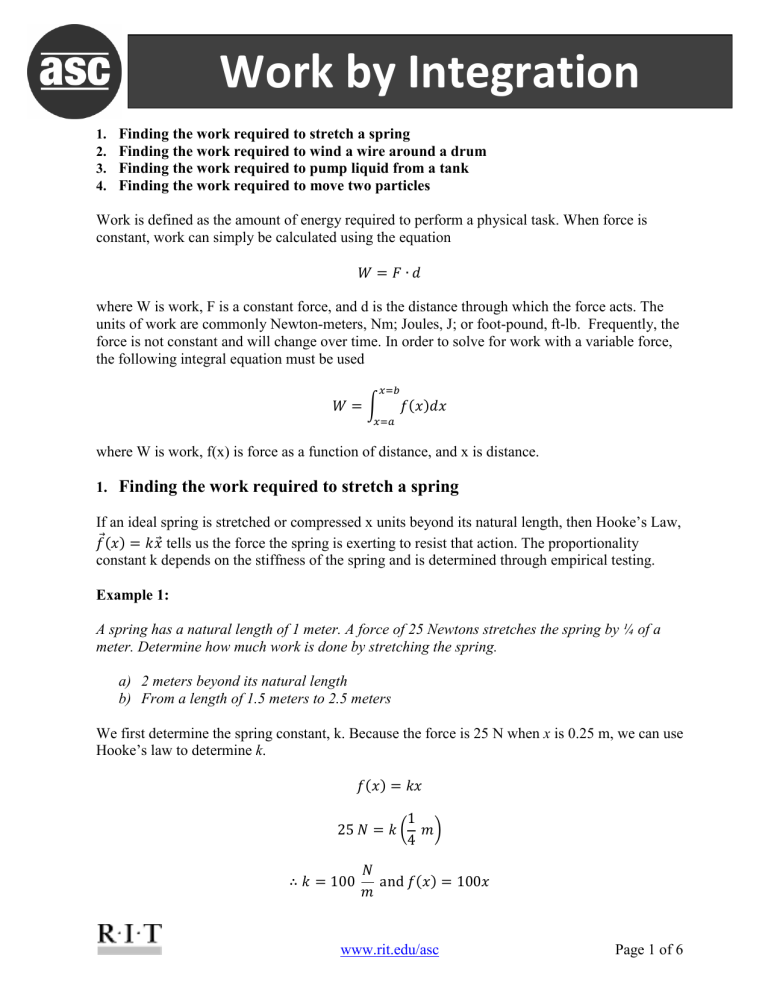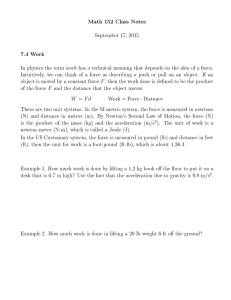
Work by Integration 1. 2. 3. 4. Finding the work required to stretch a spring Finding the work required to wind a wire around a drum Finding the work required to pump liquid from a tank Finding the work required to move two particles Work is defined as the amount of energy required to perform a physical task. When force is constant, work can simply be calculated using the equation where W is work, F is a constant force, and d is the distance through which the force acts. The units of work are commonly Newton-meters, Nm; Joules, J; or foot-pound, ft-lb. Frequently, the force is not constant and will change over time. In order to solve for work with a variable force, the following integral equation must be used ( ) ∫ where W is work, f(x) is force as a function of distance, and x is distance. 1. Finding the work required to stretch a spring If an ideal spring is stretched or compressed x units beyond its natural length, then Hooke’s Law, ⃗( ) ⃗ tells us the force the spring is exerting to resist that action. The proportionality constant k depends on the stiffness of the spring and is determined through empirical testing. Example 1: A spring has a natural length of 1 meter. A force of 25 Newtons stretches the spring by ¼ of a meter. Determine how much work is done by stretching the spring. a) 2 meters beyond its natural length b) From a length of 1.5 meters to 2.5 meters We first determine the spring constant, k. Because the force is 25 N when x is 0.25 m, we can use Hooke’s law to determine k. ( ) ( ) ( ) www.rit.edu/asc Page 1 of 6 Hence, to find the work done by stretching the spring from its rest position to 2 meters beyond that resting position, we do the following: ∫ ( ) ∫ ( ) | ( ) Similarly, to find the work done by stretching the spring from a length of 1.5 m to 2.5 m: ∫ ( ) ( | ∫ ) ( ) Note: In this type of problem, we need to pay attention to boundaries. If the spring is not stretched, no matter what the length of it is, the lower boundary must be zero. If the spring is stretched to a certain length, then we need to subtract the natural length of it from that value. This then will determine the appropriate boundaries of the integral. 2. Finding the work required to wind a wire around a drum When winding up a wire, a force has to be applied to pull the mass up against gravity. Therefore, gravitational weight of the mass is equal to the required force to wind the wire. The potential energy gained by the mass is the same as the work done by winding up the wire. Example 2: Find the work generated from one revolution of the pictured massless pulley and massless wire system. The mass of the block is 3 kg. 2m For one rotational revolution of the pulley, the distance the weight is raised is equal to one circumference; therefore, . The gravitational ( ) ( force on 3 kg is determined by ) . Therefore, ∫ ∫ | (rounded to 3 significant digits) 3 kg www.rit.edu/asc Page 2 of 6 Example 3: We are given a fully extended cable of 150 feet weighing 2.00 lb/ft. How much work is done after winding 50 feet of cable? ( ) [Why (150 – x)? At the beginning there will be 150 feet of hanging cable. As the cable is wound up (by x feet) the cable becomes shorter and shorter, weighing less and less. We stop after x = 50 feet are wound, i.e., when there is only 100 feet of cable left hanging.] 1 150 ft ∫ ( ) ∫ ( ) [ ] x ft 3. Finding work required to pump liquid from a tank Pumping liquid out of the top of a tank requires work because the liquid is moving against gravity. To calculate this, we imagine the work required to lift small disks of liquid up and out of the tank. So we are lifting a series of masses against gravity and allowing the liquid to spill out once the top is reached. We are asked to calculate the work performed in all of this activity. Recall that weight = mass times the force of gravity ( ), where W is weight, m is mass, and g is the gravitational constant, or . Sometimes the weight is provided and sometimes the mass is. What varies in these systems is the distance each disc needs to be lifted, measured by taking the total height, H, and subtracting from this the present height of the remaining liquid, x, and the volume of each disc. Example 4: Find the work done by pumping out water from the top of a cylindrical tank 3.00 ft in radius and 10 ft tall, if the tank is initially full. (The density of water is ) [ ] [ ] [ [ ] [ ] ] [ ] Since Work = (Fdistance) and the distance is H – x, then ∫ ( )( )( ) ∫ ( ∫ ( ) [ ] [ ( )( )( H-x ) H x )] www.rit.edu/asc Page 3 of 6 Example 5: Find the work done by pumping out molasses from a conical tank filled to 2 ft from the top of the tank. The tank has a maximum radius of 3 ft and a height of 10 ft. Molasses weighs . 3 (3,10) r (r,h) The added difficulty here results from the fact that as the height through which each disc is lifted changes, so does the radius change. We would prefer to integrate with respect to a single variable; therefore, we seek a relationship between the variables h and r. 10 h (0,0) Using similar triangles: [ ∫ ( )( ] [ )( ) ∫ ( ] [ ] ∫ ( )( ( ) [ ) )( [ ] [ ) ] ] [ ∫ [ ] ( ) ] 4. Finding the work required to move two particles q1 F q2 F R + + Coulomb’s Law states that ; like charges repel, opposite charges attract, where k, the proportionality constant is approximately equal to . Therefore, the energy required to bring two particles of charge q1 and q2 from infinity to a distance, R, is: www.rit.edu/asc Page 4 of 6 ∫ ∫ ∫ [ ] [ ( )] Notice the similarity between this and Newton’s Law of Gravitation. Example: Find the work required to bring together a 0.8 nC negative charge and a 0.6 nC negative charge from a distance of 200 mm (0.2 m) to a distance of 100 mm (0.1 m). ∫ ∫ ( )( [ )( ] ) [ ( ∫ )] You Try It: Problem 1: A spring has a natural length of 250 cm. A force of 18 Newtons stretches the spring to a length of 5 meters. Determine how much work is done by stretching the spring c) 150 cm beyond its natural length d) from a length of 3.5 meters to 5.0 meters Problem 2: Find the work done winding 10 feet of a 25-ft cable that weighs 4.00 lb/ft when there is a 50 lb mass that hangs on the end. Problem 3: Find the work done by pumping out molasses from a hemispherical tank with a radius of 4 feet when the initial depth of the molasses is at 2 feet. Molasses weighs . 4 Problem 4: Find the work required when a 1.2 nC negative charge and a 0.5 nC positive charge move apart from a distance of 0.25 m to a distance of 1.00 m. www.rit.edu/asc Page 5 of 6 “You Try It” Solutions: Problem 1: (a) 8.1 N; (b) 18.9 N Problem 2: Problem 3: Problem 4: www.rit.edu/asc Page 6 of 6



